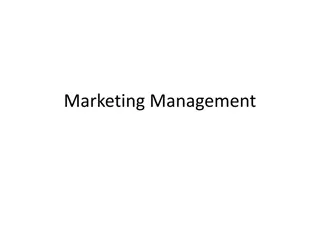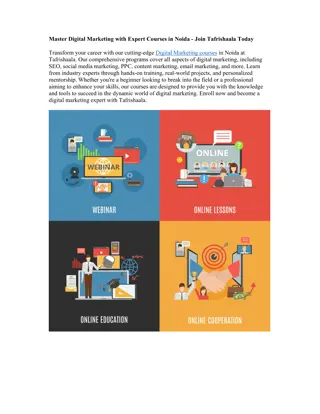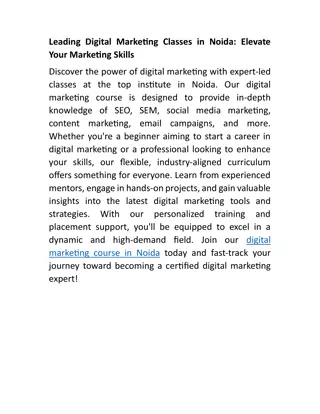Introduction to Marketing Management
Explore the fundamental concepts of marketing, including definitions by prominent figures like Philip Kotler and Peter Drucker. Learn about the importance of effective marketing in placing products in the hands of target customers.
Download Presentation

Please find below an Image/Link to download the presentation.
The content on the website is provided AS IS for your information and personal use only. It may not be sold, licensed, or shared on other websites without obtaining consent from the author.If you encounter any issues during the download, it is possible that the publisher has removed the file from their server.
You are allowed to download the files provided on this website for personal or commercial use, subject to the condition that they are used lawfully. All files are the property of their respective owners.
The content on the website is provided AS IS for your information and personal use only. It may not be sold, licensed, or shared on other websites without obtaining consent from the author.
E N D
Presentation Transcript
Introduction to Marketing Introduction to Marketing Management Management Dr. Wan Suryani,.SE,.M.Si
What is Marketing? What is Marketing? Pemasaran adalah fungsi organisasi dan serangkaian proses untuk menciptakan, berkomunikasi, dan menyampaikan nilai kepada pelanggan dan untuk pengelolaan Hubungan pelanggan dengan cara yang menguntungkan organisasi dan pemangku kepentingannya.
What is Marketing Management? What is Marketing Management? Manajemen pemasaran adalah seni dan ilmu memilih pasar sasaran dan mendapatkan, menjaga, dan berkembang pelanggan melalui penciptaan, penyampaian, dan komunikasi nilai pelanggan yang unggul
Definition of Marketing Definition of Marketing Philip Kotler - Pemasaran adalah proses Sosial & Manajerial di mana Individu & Kelompok memperoleh apa yang mereka Butuhkan dan Inginkan melalui Penciptaan, Penawaran, dan Pertukaran produk yang memiliki Nilai lain
Definition of Marketing Definition of Marketing Peter Drucker - Pemasaran adalah suatu proses sosial dimana individu dan kelompok memperoleh apa yang mereka butuhkan dan inginkan melalui penciptaan penawaran, dan secara bebas mempertukarkan produk dan jasa yang bernilai dengan pihak lain. Untuk definisi manajerial, pemasaran sering digambarkan sebagai seni menjual produk
Definition of Marketing Definition of Marketing American Marketing Association (AMA) - Pemasaran adalah proses perencanaan dan pelaksanaan konsepsi, penetapan harga, promosi, & distribusi ide, barang, & jasa untuk menciptakan pertukaran yang memenuhi tujuan individu dan organisasi.
Why Its Important Why It s Important Pemasaran yang efektif menempatkan produk di tangan pelanggan sasarannya.
Product Orientation Stage Produsen dalam tahap orientasi produk biasanya berfokus pada kualitas dan kuantitas output sambil berasumsi bahwa pelanggan akan mencari dan membeli produk dengan harga terjangkau dan dibuat dengan baik. Di era ketika permintaan terhadap suatu barang umumnya melebihi pasokan, fokus utama dalam bisnis adalah memproduksi produk dalam jumlah besar secara efisien. Menemukan pelanggan dipandang sebagai fungsi yang relatif kecil.
Sales Orientation Stage Krisis ekonomi dunia pada akhir tahun 1920-an (disebut sebagai Depresi Besar) mengubah persepsi. Menemukan bahwa permasalahan perekonomian bukan lagi bagaimana melakukan produksi secara efisien, melainkan bagaimana menjual output yang dihasilkan. Menawarkan produk yang berkualitas saja bukanlah sebuah jaminan. kesuksesan Para manajer menyadari bahwa untuk menjual produk mereka kepada konsumen yang memiliki sumber daya terbatas dan banyak pilihan, diperlukan upaya pasca produksi yang besar. Tahap orientasi penjualan ditandai dengan ketergantungan yang besar pada aktivitas promosi untuk menjual produk yang ingin dibuat oleh perusahaan.
Market Orientation Stage Pada akhir perang dunia II, terdapat permintaan terpendam yang kuat terhadap barang-barang konsumsi yang disebabkan oleh kekurangan pada masa perang Dalam upaya untuk merangsang penjualan, perusahaan kembali ke aktivitas promosi & penjualan yang agresif di era orientasi penjualan Penjual menyadari bahwa tahun-tahun perang juga telah mengubah konsumen Selain itu, upaya perang membawa banyak perempuan keluar rumah dan memasuki dunia kerja untuk pertama kalinya Selain itu konsumen mempunyai lebih banyak pilihan Teknologi yang dikembangkan selama perang memungkinkan produksi barang yang jauh lebih beragam Pada tahap ini perusahaan mengidentifikasi apa yang diinginkan pelanggan dan menyesuaikan seluruh aktivitas perusahaan untuk memenuhi kebutuhan tersebut seefisien mungkin
One fundamental question: Is One fundamental question: Is Marketing creating or satisfying needs? Marketing creating or satisfying needs?
Key Key Words Words market marketing marketing concept target marketing relationship marketing marketing mix break-even point
Key Key Words Words market research demographics channel of distribution direct distribution indirect distribution wholesaler retailer
MARKETING IS AN ORGANISATIONAL FUNCTION The diagram below shows the many functions that can be carried out in organisations which, dependant on the organisation, can be classified as operational functions of marketing. CRM Sales Promotion Advertising P.R. Selling Display Financing Stockholding The operational functions of marketing Buying Servicing Forecasting Risk Taking Pricing Transporting Market Research Merchandising Publicity
MARKETING AS A MANAGEMENTFUNCTION Here the role of marketing is ensuring that the operational activities of the organisation (not just marketing) are clearly directed towards the principal objective of meeting the needs of the customers effectively. It involves analysing customers and anticipating their needs, planning, resource allocations, control and investment in terms of money, appropriate skilled people and physical resources to ensure both customer and organisational needs are met to each s satisfaction. Marketing as a Business Concept in this regard marketing is the study of exchange processes especially those associated with the provision of goods and services. It takes its lead from the social sciences in that, the basic tenant of society is that we all need each other. The idea here is, if I ve got something you want and you ve got something I want, then we do a deal (which is the exchange process)
MARKETING AS A BUSINESS CONCEPT The Exchange Process Something of value Goods, services, benefits Supplier Customer Money, exchange of goods Something of value
EXCHANGE TRANSACTIONS Consumers Costs & Benefits Organisations Cash Quench thirst Customer Pepsi Insurance premiums Medical treatment Patient Private Hospital Fees Education Student University
EXCHANGE TRANSACTIONS Consumers Costs & Benefits Organisations Time Sense of community service Volunteer Non-profit youth group Vote Sense of economic/social progress continued employment etc Voter Politic Party Taxes Reader Lone parent Public Library, Benefit agency
MARKETING AS A BUSINESS PHILOSOPHY Simply a way (i.e. orientation) towards how the business will behave. As a philosophy it recognises the importance of the customer and that all business exists to serve customers rather than manufacturing products. To quote Adam Smith C A in his famous text The wealth of Consumption is the sole purpose of production and the interests of the product ought to be attended o only so far as it may be necessary for promoting those of the customer
CORE CONCEPTS OF MARKETING Needs Products/ Value Wants Services & Demand Satisfaction Exchange Process Markets Marketing Exchange Transactions Relationships
EVOLUTION OF MARKETING CONCEPT AND MARKETING ORIENTATION Self-sufficiency No exchange process Simple Start of exchange process Local markets Economic specialisations Money economy Medium of exchange Industrial revolution Rapid growth in world population leading to increased demand. Problem How to supply? Production orientation More efficient production eventually led to oversupply. Problem changed to How to dispose? Soles orientation Economic theory states: when supply exceeds demand, reduce price and use other techniques to stimulate demand. Product orientation Demand. Problem how to keep customers? Companies sought to keep customers by increasing emphasis on product design, Problem competition quickly copied and the design didn t suit everyone. Too many products than they demand for them. Marketing orientation capabilities of the company to ensure both parties needs were satisfied. Production based on customer needs and wants. Specific markets identified and matched their requirements to the
BUSINESS ORIENTATION Orientation Profit Driver Approximate Time Frame Characteristics Production Production Methods Improvement of production and in order to achieve a reduction of costs and improved efficiency. Up to 1940 s Product Quality of Product The quality of the product is paramount. Focus on product not customer needs. Until 1960 s Selling Selling Methods 1950-1970 s Effective selling and promotion are the new drivers to success. Marketing Needs and wants of customers 1970 to date Focus on providing the goods and services that satisfy the needs and wants of consumers. Further approaches to marketing Relationship Marketing Building and keeping good customer relations Emphasis placed on keeping as well as winning customer strategies. 1990 s to date Societal Marketing Benefit the society Similar to marking orientation but also concerned with the long term impact of organisational activities on the environment (society) 1990 s to date
Marketing Mix: The 4 Ps Place Promotion Product The Marketing Mix Price
Importance of 4Ps by Industry examples of promotions Consumer Goods Industrial Goods High Advertising Personal Selling Sales Promotion Sales Promotion Importance Personal Selling Advertising PR PR Low
Push versus Pull Demand Demand Push Strategy Manufacturer Intermediary End User e.g Lever Brothers Demand Demand Pull Strategy Manufacturer Intermediary End User e.g. P & G























